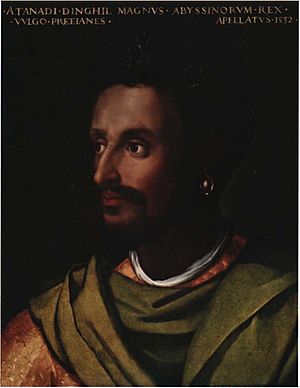Dawit II facts for kids
Quick facts for kids Dawit II |
|||||
|---|---|---|---|---|---|
| Negusa Nagast | |||||

Contemporary portrait of Lebna Dengel by Cristofano dell'Altissimo
|
|||||
| Emperor of Ethiopia | |||||
| Reign | 13 August 1507 – 2 September 1540 | ||||
| Coronation | 13 May 1508 | ||||
| Predecessor | Na'od | ||||
| Successor | Gelawdewos | ||||
| Regent | Empress Eleni | ||||
| Born | c. 1496 Debre Damo, Ethiopian Empire |
||||
| Died | 2 September 1540 (aged 43-44) | ||||
| Burial | Abba Aragwi Monastery | ||||
| Spouse | Seble Wongel | ||||
| Issue |
|
||||
|
|||||
| Dynasty | House of Solomon | ||||
| Father | Na'od | ||||
| Mother | Na'od Mogesa (ናዖድ ሞገሳ) | ||||
Dawit II (also known as David II) was an Emperor of Ethiopia. He was born around 1496 and ruled from 1508 to 1540. His birth name was Lebna Dengel. He was also called Wanag Segad, which means "to whom lions bow."
Dawit II was a member of the Solomonic dynasty, a royal family with a long history in Ethiopia. His father was Emperor Na'od. Dawit II became emperor after his father died. He faced many challenges during his rule, especially from a powerful neighboring state called the Adal Sultanate.
Biography
Early life and reign
Unlike many rulers of his time, Dawit II had only one wife, Seble Wongel. They married around 1512 or 1513 and had eight children together. Having only one wife was seen as a very Christian act.
When Dawit II was young, his step-great-grandmother, Empress Mother Eleni, helped him rule. She was his regent until he was old enough in 1516. Eleni was worried about the powerful Muslim states nearby. These states were getting help from larger Muslim countries like the Ottoman Empire.
To get help for Ethiopia, Eleni sent a man named Mateus to Portugal. Portugal was a strong Christian country in Europe. However, it took a long time for Portugal to respond. A Portuguese group finally arrived in Ethiopia in 1520. One of them, Francisco Álvares, described Emperor Dawit II. He said Dawit was a young man, about 23 years old, with a round face and large eyes.
In 1517, Dawit II's forces defeated Emir Mahfuz of Adal. Around the same time, a Portuguese fleet attacked and burned Zeila, a Muslim city. People thought the threat from Muslim states was over. So, when the Portuguese arrived, Dawit II didn't think he needed their help anymore. He ignored Eleni's advice. The Portuguese left after six years. But Dawit II and his leaders were wrong; the danger was not over.
Facing challenges
After 1520, a new leader named Ahmad ibn Ibrahim al-Ghazi (known as "the Imam") became very powerful in the Adal Sultanate. He wanted to conquer the Ethiopian Empire. In 1528, the Imam's army attacked Ethiopian lands. They looted and burned towns.
The Imam's soldiers were used to quick raids, not big battles. Many of them left his army at first. But Emperor Dawit II caught up with the Imam's forces. They fought a battle called the Battle of Shimbra Kure in March 1529. Dawit II's army did not destroy the Imam's forces. This battle showed the Imam's followers that they could fight and win against the Ethiopian army.
The Imam attacked Ethiopia again in 1531. This time, he used cannons, which were new to the region. Dawit II's army was defeated. The Emperor had to retreat into the mountains. He tried to protect the passes into his home region, Bet Amhara. His general, Wasan Sagad, was killed in battle.
In October, the Imam surprised the Emperor at the Battle of Amba Sel. Dawit II almost got captured. After this, he could not fight a large battle against his enemies again. The Imam's followers then swept through Bet Amhara. They looted and burned many churches. Dawit II had to hide behind the Abay River in Gojjam. The Muslims were only slowed down when they failed to capture the royal treasury at Amba Geshen.
In 1533, the Imam gathered his troops again. He planned to conquer or destroy the northern parts of Ethiopia. Both Ethiopia and Dawit II suffered greatly from these attacks. Many monasteries and churches were burned and looted. Dawit II's oldest son, Fiqtor, was killed in 1537. Another son, Menas, was captured in 1539 and sent away. The royal prison at Amba Geshen was captured in 1540. The royal prisoners there were killed, and the treasury was looted.
Later years
During these difficult years, Dawit II realized that Empress Eleni had been right about needing help from Europe. He sent João Bermudes, who had come with the Portuguese, to ask for help again. However, this help, led by Cristóvão da Gama, arrived after Dawit II died.
Emperor Dawit II died on September 2, 1540. He passed away in a monastery on a mountain called Debre Damo.
A historian named Taddesse Tamrat wrote that the Muslim control of the Christian highlands lasted only about ten years. But the damage caused during these years was huge, like centuries of destruction.
Dawit II was followed by his son, Gelawdewos, as the next emperor. His son Menas was still a prisoner. Menas was later freed in 1543. Another of Dawit II's younger sons, Yaqob, is said to have hidden in a province called Menz. Yaqob's grandson, Susenyos I, later became Emperor in 1604.
Images for kids
See also
 In Spanish: David II de Etiopía para niños
In Spanish: David II de Etiopía para niños



